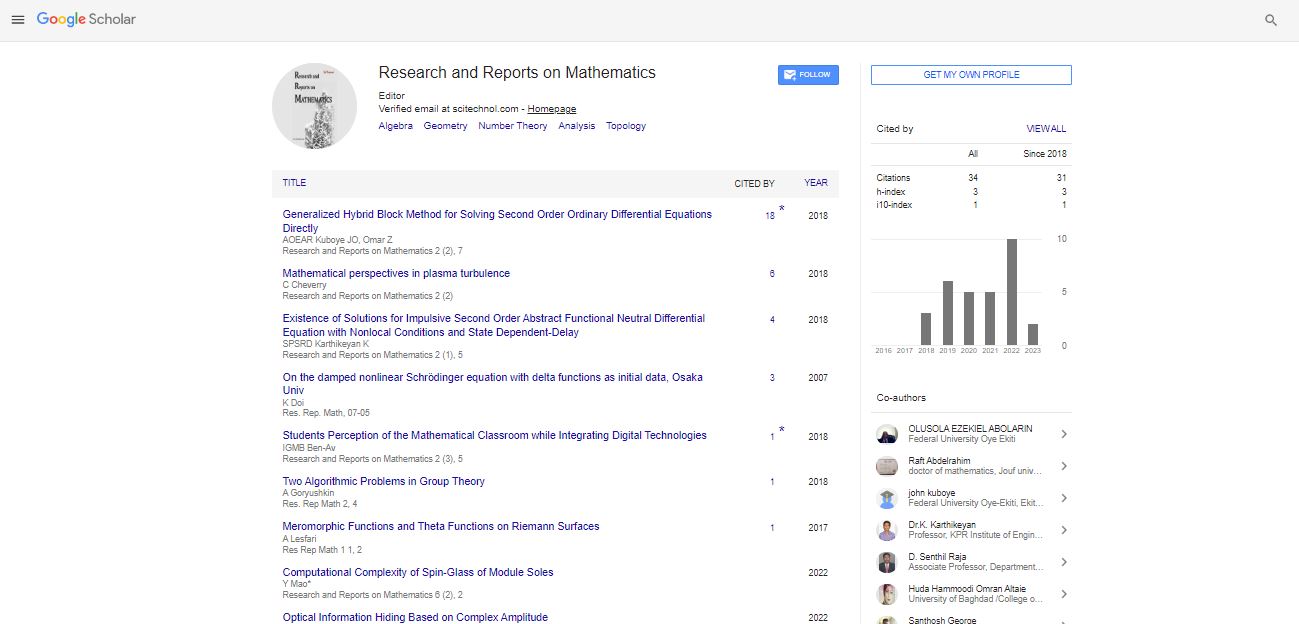Editorial, Res Rep Math Vol: 5 Issue: 4
Extensions in Jacobian algebras and cluster categories of marked surfaces
Baji Shaik*
Department of Mathematics, University of Sapienza Rome, Rome
- *Corresponding Author:
- Baji Shaik
Department of Mathematics, University of Sapienza Rome, Rome
Tel: 8519974606
E-mail: baji345@gmail.com
Received Date: April 13, 2021; Accepted Date: April 15, 2021; Published Date: April 17, 2021
Citation: Shaik B. (2021) Extensions In Jacobian Algebras And Cluster Categories Of Marked Surfaces. Res Rep Math 5:1.
Copyright: © All articles published in Research and Reports on Mathematics are the property of SciTechnol, and is protected by copyright laws. Copyright © 2021, SciTechnol, All Rights Reserved.
Abstract
In the context of representation theory of finite dimensional algebras, string algebras are extensively studied and most aspects of their representation theory are well-understood. One exception to the present is that the classification of extensions between indecomposable modules. During this paper we explicitly describe such extensions for a category of string algebras, namely gentle algebras associated to surface triangulations. These algebras arise as Jacobian algebras of unpunctured surfaces. We relate the extension spaces of indecomposable modules to crossings of generalised arcs within the surface and provide explicit bases of the extension spaces for indecomposable modules in most cases. We show that the size of those extension spaces is given in terms of crossing arcs within the surface. Our approach is new and consists of interpreting snake graphs as indecomposable modules. So as to point out that our basis may be a spanning set, we'd like to figure within the associated cluster category where we explicitly calculate the centre terms of extensions and provides bases of their extension spaces.
Keywords: Interpreting, Snake, Graphs, Indecomposable, Modules.
Introduction
Cluster algebras were introduced by Fomin and Zelevinsky in 2002 so as to offer an algebraic framework for the study of the (dual) canonical bases in Lie theory. This work was further developed. Cluster algebras are commutative algebras given by generators, the cluster variables, and relations. The development of the generators may be a recursive process from an initial set of knowledge generally, even in small cases; this is often a complex process. However, there’s a category of cluster algebras coming from surfaces where this process is encoded within the combinatorial geometry of surface triangulations. Surface cluster algebras are a crucial a part of the classification of (skew-symmetric) cluster algebras in terms of mutation type, namely most cluster algebras of finite mutation type are surface cluster algebras.
Cluster algebras from surfaces are widely studied via the combinatorial geometry of the corresponding surfaces. An equivalent holds true for the associated cluster categories and Jacobian algebras. A crucial example of this is often the crossing of two arcs during a surface. Within the case of cluster algebras this provides rise to a multiplication formula for the corresponding cluster variables. Within the cluster category, the amount of crossings of two arcs gives the dimension of the extension space between the associated indecomposable objects. For Jacobian algebras of surfaces where all marked points dwell the boundary, Auslander–Reiten sequences are given in terms of arcs within the surface. Generally, however, there has thus far been no link between arbitrary crossings of arcs within the surface and therefore the extensions between indecomposable modules with the Jacobian algebra.
The Jacobian algebras into account are gentle algebras and their indecomposable modules, given by strings and bands, correspond to curves and closed curves within the surface for a more general definition of Jacobian algebras via quiver with potential for classification of their representation type. Gentle algebras form a special class of algebras, for instance, this class is closed under tilting and derived equivalence. They’re a part of the larger family of string algebras which are a crucial family of algebras of tame representation type whose representation theory is well-understood. For instance, their Auslander–Reiten structure has been determined within the morphisms between indecomposable modules are completely described. However, an entire description of the extensions between indecomposable modules isn’t known.
In the present paper, we describe extension spaces of string modules over gentle Jacobian algebras. Furthermore, we show that in analogy with the cluster category, in most cases, the amount of crossings of two arcs still gives rise to a dimension formula of the extension space between the corresponding indecomposable modules within the Jacobian algebra by explicitly constructing a basis. However, not every crossing contributes to the present dimension. We characterise exactly which crossings contribute and which do not. We do that by introducing a replacement approach, consisting of using the snake graph calculus developed to explicitly construct extensions resulting from crossing arcs. This provides a boundary on the size of the extensions spaces within the Jacobian algebra. So as to get an boundary, we add the cluster category. There we show explicitly how, in many cases, the four arcs within the surface, resulting from the smoothing of a crossing of two not necessarily distinct arcs, produce to two extensions within the cluster category.
For surface cluster algebra, the cluster variables are in bijection with arcs within the surface. Moreover, during a given triangulation, each arc corresponds to a combinatorial object called a snake graph. Snake graphs have proven to be a crucial element within the understanding of surface cluster algebras, for instance, in snake graphs (and band graphs) were wont to show that certain collections of loops and (generalised) arcs comprise vector space bases for surface cluster algebras. Snake graphs have also been instrumental within the proof of the positivity conjecture for surface cluster algebras. Note that the conjecture has since been proved for all skew-symmetric cluster algebras.
 Spanish
Spanish  Chinese
Chinese  Russian
Russian  German
German  French
French  Japanese
Japanese  Portuguese
Portuguese  Hindi
Hindi 